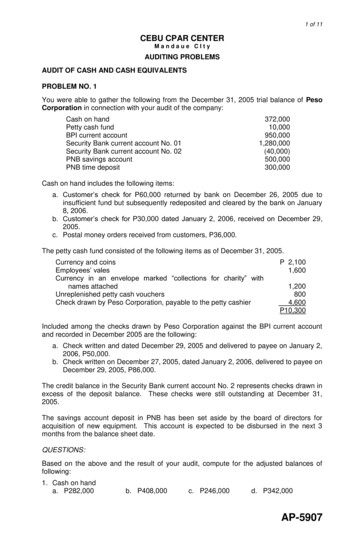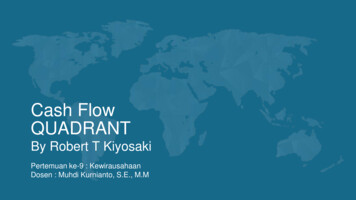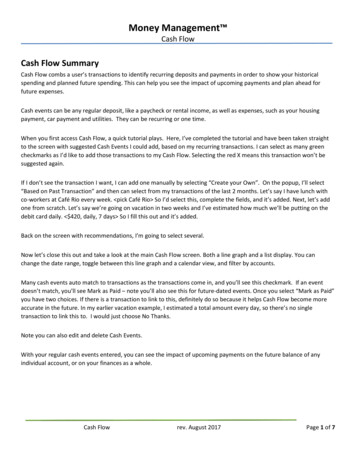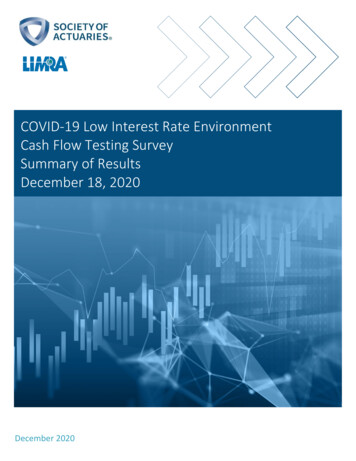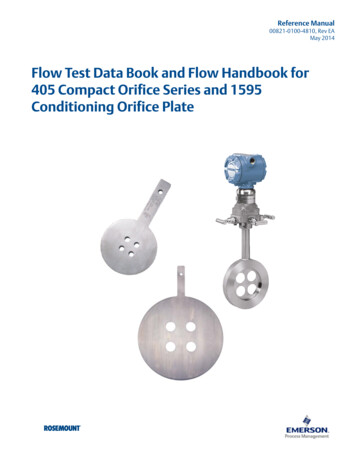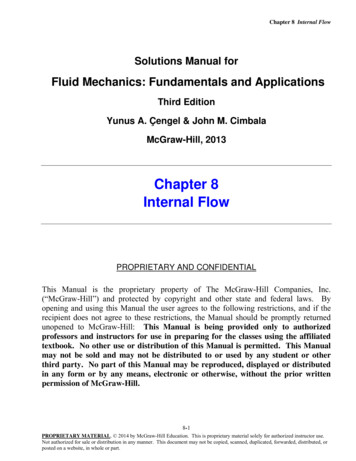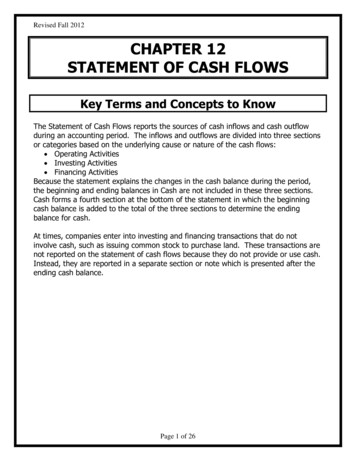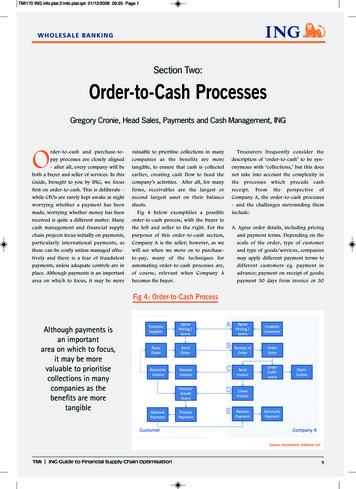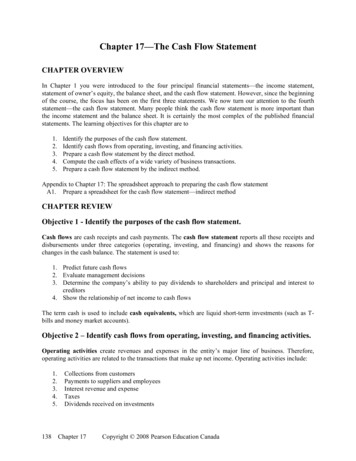
Transcription
Chapter 17—The Cash Flow StatementCHAPTER OVERVIEWIn Chapter 1 you were introduced to the four principal financial statements—the income statement,statement of owner’s equity, the balance sheet, and the cash flow statement. However, since the beginningof the course, the focus has been on the first three statements. We now turn our attention to the fourthstatement—the cash flow statement. Many people think the cash flow statement is more important thanthe income statement and the balance sheet. It is certainly the most complex of the published financialstatements. The learning objectives for this chapter are to1.2.3.4.5.Identify the purposes of the cash flow statement.Identify cash flows from operating, investing, and financing activities.Prepare a cash flow statement by the direct method.Compute the cash effects of a wide variety of business transactions.Prepare a cash flow statement by the indirect method.Appendix to Chapter 17: The spreadsheet approach to preparing the cash flow statementA1. Prepare a spreadsheet for the cash flow statement—indirect methodCHAPTER REVIEWObjective 1 - Identify the purposes of the cash flow statement.Cash flows are cash receipts and cash payments. The cash flow statement reports all these receipts anddisbursements under three categories (operating, investing, and financing) and shows the reasons forchanges in the cash balance. The statement is used to:1. Predict future cash flows2. Evaluate management decisions3. Determine the company’s ability to pay dividends to shareholders and principal and interest tocreditors4. Show the relationship of net income to cash flowsThe term cash is used to include cash equivalents, which are liquid short-term investments (such as Tbills and money market accounts).Objective 2 – Identify cash flows from operating, investing, and financing activities.Operating activities create revenues and expenses in the entity’s major line of business. Therefore,operating activities are related to the transactions that make up net income. Operating activities include:1.2.3.4.5.138Collections from customersPayments to suppliers and employeesInterest revenue and expenseTaxesDividends received on investmentsChapter 17Copyright 2008 Pearson Education Canada
Operating activities are always listed first because they are the largest and most important source of cashfor a business. Operating activities are related to the transactions that make up net income.Investing activities increase and decrease the long-term assets with which the business works. Investingactivities require analysis of the long-term asset accounts and include:1. Buying and selling capital and investments2. Lending money to others and collecting principal repaymentsInvesting activities are critical because they help determine the future course of the business. Investingactivities are related to the long-term asset accounts.Financing activities obtain the funds from investors and creditors needed to launch and sustain thebusiness. Financing activities require analysis of the long-term liability accounts and the owners’ equityaccounts and include:1.2.3.4.Issuing shares.Repurchase of company shares.Paying dividends.Borrowing money and repaying the principal.Study Tip: While principal payments on notes and bonds payable are a financing activity, the interestpayments are classified as an operating activity.Study Tip: The following relationships are important to remember1. Operating activities relate to net income2. Investing activities relate to long-term assets3. Financing activities relate to long-term liabilities and owners’ equityReview Exhibit 17-5 in your text and become familiar with both the format and content of a cash flowstatement.Objective 3 - Prepare a cash flow statement by the direct method.The cash flow statement reports cash flows from operating activities, investing activities, and financingactivities. It calculates the net increase or decrease in cash over the year, and adds that to the previousyear’s cash balance in order to arrive at the current year’s cash balance. It shows where cash came fromand how it was spent.The CICA Handbook permits two methods for presenting the cash flow statement—the direct method andthe indirect method. However, the Handbook recommends the direct method because it shows where cashcame from and how it was spent on operating activities.Preparing the cash flow statement requires these steps:1. Identify items that affect cash2. Classify the items as operating activities, investing activities, or financing activities3. Determine the increase or decrease in cash for each itemCopyright 2008 Pearson Education CanadaThe Cash Flow Statement139
Cash flows from operating activities include1.2.3.4.5.6.cash collections from customerscash receipts of interestcash receipts of dividendspayments to supplierspayments to employeespayments for interest and taxesCash flows from investing activities include1. payments for capital assets, investments, and loans, to others2. proceeds from the sale of capital assets, investments, and the collections of loansCash flows from financing activities include1. proceeds from issuance of shares and notes payable2. payments of notes payable and purchases of the company’s own shares3. payment of cash dividendsObjective 4 - Compute the cash effects of a wide variety of business transactions.Accounts may be analyzed for the cash effects of various transactions using the income statementamounts in conjunction with changes in the balance sheet amounts.To determine cash flow amounts from operating activities, keep the following in mind:Revenue/expense from theincome statementAdjust for the change in relatedbalance sheet accountsAmount for theCash flow statementCash collections from customers can be computed using Sales Revenue from the income statement andthe changes in Accounts Receivable from the balance sheet:COLLECTIONSFROMCUSTOMERS SALES REVENUE DECREASES IN ACCOUNTS RECEIVABLEor- INCREASES IN ACCOUNTS RECEIVABLECash receipts for interest and dividends are analyzed in the same manner.Payments to suppliers computation:PAYMENTSFORINVENTORY140Chapter 17 COST OFGOODSSOLD INCREASE ININVENTORYor- DECREASE ININVENTORYandCopyright 2008 Pearson Education Canada DECREASE INACCOUNTS PAYABLEorINCREASE INACCOUNTS PAYABLE
Payments for operating expenses computation:PAYMENTSFOROPERATINGEXPENSES OPERATINGEXPENSES OTHERTHAN SALARIES,WAGES, ANDAMORTIZATION INCREASE INPREPAIDEXPENSESor- DECREASE INPREPAIDEXPENSEand DECREASE INACCRUEDLIABILITIESor- INCREASE INACCRUEDLIABILITIESRemember that amortization is not included in operating expenses because amortization is a noncashexpense.Payments to employees computation:PAYMENTSTOEMPLOYEES SALARYAND WAGEEXPENSE DECREASES IN SALARY AND WAGE PAYABLEor- INCREASES IN SALARY AND WAGE PAYABLEPayments of interest and taxes follow the same pattern as payments to employees. Exhibit 17-12summarizes this discussion.For investing activities we look to the asset accounts (Capital Assets, Investments, Notes Receivable).Capital asset transactions can be analyzed by first determining book value:BEGINNINGCAPITALASSETBALANCE(NET) ACQUISITIONS- AMORTIZATIONBOOK VALUE- OF CAPITALASSETS SOLDENDING CAPITALASSETBALANCE(NET)In order to compute cash proceeds from a sale of capital assets:SALEPROCEEDS BOOK VALUESOLD GAIN- LOSSAcquisitions will decrease cash, while sale proceeds will increase cash.Investments, Loans and Notes Receivable are analyzed in a manner similar to capital assets; however,there is no amortization to account for. Review Exhibit 17-12 for a summary of this discussion.Financing activities affect liability and shareholders’ equity accounts.Copyright 2008 Pearson Education CanadaThe Cash Flow Statement141
Long-term debt can be analyzed with this equation:BEGINNINGLONG-TERMDEBTBALANCE ISSUANCEOFNEW DEBT-ENDINGLONG-TERMDEBTBALANCEPAYMENTS Share transactions can be analyzed using this equation:BEGINNINGSHARESBALANCE ISSUANCEOFNEW SHARES-RETIREMENTS ENDINGSHARESBALANCEIssuances increase cash, while retirements decrease cash.Dividend payments can be computed by analyzing Retained Earnings:BEGINNINGRETAINEDEARNINGSBALANCE NETINCOMEDIVIDENDS- DECLARATIONS ENDINGRETAINEDEARNINGSBALANCERemember that stock dividends must be separated from cash dividends. Also, a change in the DividendsPayable account will affect the actual cash dividends paid. Review page 928 in your text.Noncash investing and financing activitiesSome investing and financing activities are noncash. Some typical noncash investing and financingactivities include:1. Acquisition of assets by issuing shares2. Acquisition of assets by issuing debt3. Payment of long-term debt by transferring investment assets to the creditorNoncash activities are included in a schedule or a note to the cash flow statement.Objective 5 - Prepare a cash flow statement by the indirect method.The indirect or (reconciliation) method reconciles net income to cash flows and affects only theoperating activities section of the statement. The investing activities and financing activities sections areidentical to the sections prepared using the direct method.To prepare the operating activities section using the indirect method, we must add and subtract items thataffect net income and cash flows differently. Begin with net income from the income statement.1. Amortization is a noncash expense that reduces net income. Therefore, we add it back to netincome as part of our effort to arrive at cash flow from operations.2. Gains and losses from the sale of capital assets are reported as part of net income, and theproceeds are reported in the investing activities section. To avoid counting gains and losses twice,142Chapter 17Copyright 2008 Pearson Education Canada
we must remove their effect from net income. Therefore, gains are subtracted from net incomeand losses are added to net income.3. Changes in current assets and current liabilities:a. Increases in current assets, other than cash, are subtracted from net income.b. Decreases in current assets, other than cash, are added to net income.c. Decreases in current liabilities, other than dividends payable, are subtracted from net income.d. Increases in current liabilities are added to net income.Study Tip: Under the indirect method, only changes in current assets and current liabilities are used.Review Exhibit 17-12 in your text.Cash flows are only one source of information creditors and investors use to evaluate a company. TheDecision Guidelines in your text provide an excellent summary of questions, factors to consider, andfinancial statement predictors from both a creditor’s and an investor’s perspective.Chapter Appendix:StatementThe Spreadsheet Approach to Preparing the Cash FlowObjective A1 - Prepare a spreadsheet for the cash flow statement—indirect method.A spreadsheet is frequently used as an aid in preparing the cash flow statement. Regardless of approach(direct or indirect), the format is the same. The spreadsheet has four columns, with the upper half labeledas follows:(1)Beginning BalanceSheet Amounts(2)(3)Transaction AnalysisDebitCredit(4)Ending BalanceSheet AmountsThe lower half of the spreadsheet uses only the two analysis columns and provides the amounts needed topresent the cash flow statement. For both the direct and indirect method, cash flows from investing andfinancing activities are analyzed in the same manner. (Remember, the two methods differ only in thepresentation of cash flows from operating activities.)To use the spreadsheet for the indirect method, start by entering beginning and ending balance sheetamounts on the upper half of the spreadsheet, with the transaction analysis columns in the middle.However, the lower half of the spreadsheet starts with net income (listed as a debit with an offsettingcredit to Retained Earnings). Increases and decreases in current assets and current liabilities are reconciledas changes to net income. For example, an increase in accounts receivable is analyzed with a debit toAccounts Receivable and a credit to Net Income. After all the balance sheet changes have been reconciledto changes in net income, the net increase (or decrease) in cash during the period is listed. Review Exhibit17A-2 in your text.Copyright 2008 Pearson Education CanadaThe Cash Flow Statement143
TEST YOURSELFAll the self-testing materials in this chapter focus on information and procedures that your instructor islikely to test in quizzes and examinations. Questions followed by the letter A relate to information in thechapter Appendix.I. Matching Match each numbered term with its lettered definition.1.2.3.4.5.cash equivalentsdirect methodindirect methodoperating activitycash flows6.7.8.9.financing activityinvesting activitycash flow statementspreadsheetA. a report of cash receipts and cash payments classified according to the entity’s major activities:operating, investing, and financingB. activity that creates revenue or expense in the entity’s major line of businessC. activity that increases or decreases the non-current or long-term assets with which the business hasto workD. activity that obtains from creditors the funds needed to launch and sustain the business or repayssuch fundsE. cash receipts and cash paymentsF. format of the operating activities section of the cash flow statement that lists the major categories ofoperating cash receipts and cash paymentsG. format of the operating activities section of the cash flow statement that starts with net income andshows the reconciliation from net income to operating cash flowsH. highly liquid short-term investments that can be converted into cash with little delayI. a columnar tool used to analyze changes in account balances to derive the amounts for the cashflows statementII. Multiple Choice Circle the best answer.1. All of the following are uses of the cash flow statement except:A. evaluate employee performanceB. evaluate management decisionsC. predict fu
Chapter 17—The Cash Flow Statement CHAPTER OVERVIEW In Chapter 1 you were introduced to the four principal financial statements—the income statement, statement of owner’s equity, the balance sheet, and the cash flow statement. However, since the beginning of the course, the focus has been on the first three statements. We now turn our attention to the fourth
